Numerical Study of Fracture Network Evolution during Nitrogen Fracturing Processes in Shale Reservoirs
Abstract
:1. Introduction
2. Governing Equations for Each Physical Process
2.1. Governing Equations for the Mechanical Deformation
2.2. A General Model for Porosity and Permeability
2.3. Governing Equation for Fracturing Fluid Flow
2.4. Damage Variables and Their Evolution
2.4.1. Tensile Damage Criterion
2.4.2. Shear Damage Criterion
2.4.3. Relationship between Damage and Permeability
3. Verification of This Numerical Model
3.1. Experimental Observations in the Nitrogen Fracturing Process
3.2. Numerical Simulation
4. Fracture Network Evolution during Nitrogen Fracturing
4.1. Comparison between Water Fracturing and Nitrogen Fracturing
4.2. Impact of Stress Ratio
4.3. Impact of Bedding Angle
4.4. Impact of Strength Ratio
5. Conclusions
Author Contributions
Acknowledgments
Conflicts of Interest
References
- Hyman, J.D.; Karra, S.; Makedonska, N.; Gable, C.W.; Painter, S.L.; Viswanathan, H.S. dfnWorks: A discrete fracture network framework for modeling subsurface flow and transport. Comput. Geosci. 2015, 84, 10–19. [Google Scholar] [CrossRef] [Green Version]
- Britt, L. Fracture stimulation fundamentals. J. Nat. Gas Sci. Eng. 2012, 8, 34–51. [Google Scholar] [CrossRef]
- Middleton, R.S.; Carey, J.W.; Currier, R.P.; Hyman, J.D.; Kang, Q.; Karra, S.; Jiménez-Martínez, J.; Porter, M.L.; Viswanathan, H.S. Shale gas and non-aqueous fracturing fluids: Opportunities and challenges for supercritical CO2. Appl. Energy 2015, 147, 500–509. [Google Scholar] [CrossRef]
- Lin, C.; He, J.; Li, X.; Wan, X.; Zheng, B. An experimental investigation into the effects of the anisotropy of shale on hydraulic fracture propagation. Rock Mech. Rock Eng. 2017, 50, 543–554. [Google Scholar] [CrossRef]
- Matsunaga, I.; Kobayashi, H.; Sasaki, S.; Ishida, T. Studying hydraulic fracturing mechanism by laboratory experiments with acoustic emission monitoring. Int. J. Rock Mech. Min. Sci. 1993, 30, 909–912. [Google Scholar] [CrossRef]
- Zhao, H.; Chen, M.; Jin, Y.; Ding, Y.; Wang, Y. Rock fracture kinetics of the fracture mesh system in shale gas reservoirs. Pet. Explor. Dev. 2012, 39, 465–470. [Google Scholar] [CrossRef]
- Hou, B.; Chen, M.; Li, Z.M.; Wang, Y.H.; Diao, C. Propagation area evaluation of hydraulic fracture networks in shale gas reservoirs. Pet. Explor. Dev. 2014, 41, 833–838. [Google Scholar] [CrossRef]
- Chen, L.; Chen, W.; Chen, Y.; Benyamin, L.; Li, A. Investigation of hydraulic fracture propagation using a post-peak control system coupled with acoustic emission. Rock Mech. Rock Eng. 2015, 48, 1233–1248. [Google Scholar] [CrossRef]
- Weng, X. Modeling of complex hydraulic fractures in naturally fractured formation. J. Unconv. Oil Gas Resour. 2015, 9, 114–135. [Google Scholar] [CrossRef]
- Dehghan, A.N.; Goshtasbi, K.; Ahangari, K.; Jin, Y.; Bahmani, A. 3D numerical modeling of the propagation of hydraulic fracture at its intersection with natural (pre-existing) fracture. Rock Mech. Rock Eng. 2017, 50, 367–386. [Google Scholar] [CrossRef]
- Hyman, J.D.; Jiménez-Martínez, J.; Viswanathan, H.S.; Carey, J.W.; Porter, M.L.; Rougier, E.; Karra, S.; Kang, Q.; Frash, L.; Chen, L.; Lei, Z. Understanding hydraulic fracturing: A multi-scale problem. Phil. Trans. R. Soc. A 2016, 374, 20150426. [Google Scholar] [CrossRef] [PubMed]
- Zhang, C.; Ranjith, P.G. Experimental study of matrix permeability of gas shale: An application to CO2-based shale fracturing. Energies 2018, 11, 702. [Google Scholar] [CrossRef]
- Wang, H.; Li, G.; Shen, Z. A feasibility analysis on shale gas exploitation with supercritical carbon dioxide. Energy Source Part A 2012, 34, 1426–1435. [Google Scholar] [CrossRef]
- Cao, Z.Z.; Zhou, Y.J.; Zhang, Q.; Wang, E.Q. Mechanical analysis of the coupled gas-solid-thermal model during rock damage. CMC-Comput. Mater. Con. 2015, 47, 203–215. [Google Scholar] [CrossRef]
- Stringfellow, W.T.; Domen, J.K.; Camarillo, M.K.; Sandelin, W.L.; Borglin, S. Physical, chemical, and biological characteristics of compounds used in hydraulic fracturing. J. Hazard. Mater. 2014, 275, 37–54. [Google Scholar] [CrossRef] [PubMed]
- Chen, Y.; Pope, T.L.; Lee, J.C. Novel CO2-emulsified viscoelastic surfactant fracturing fluid system. In Proceedings of the SPE European Formation Damage Conference, Sheveningen, The Netherlands, 25–27 May 2005. [Google Scholar]
- Bustos, O.A.; Heiken, K.R.; Stewart, M.E.; Mueller, P.M.; Lipinski, E.; Bui, T. Case study: Application of a viscoelastic surfactant-based CO2 compatible fracturing fluid in the frontier formation, Big Horn Basin, Wyoming. In Proceedings of the Rocky Mountain Oil & Gas Technology Symposium, Denver, CO, USA, 16–18 April 2007. [Google Scholar]
- Gu, M.; Mohanty, K.K. Effect of foam quality on effectiveness of hydraulic fracturing in shales. Int. J. Rock Mech. Min. 2014, 70, 273–285. [Google Scholar] [CrossRef]
- Sun, X.; Liang, X.; Wang, S.; Lu, Y. Experimental study on the rheology of CO2 viscoelastic surfactant foam fracturing fluid. J. Pet. Sci. Eng. 2014, 119, 104–111. [Google Scholar] [CrossRef]
- Zhang, R.; Yin, X.; Winterfeld, P.H.; Wu, Y. A fully coupled thermal-hydrological-mechanical-chemical model for CO2 geological sequestration. J. Nat. Gas Sci. Eng. 2016, 28, 280–304. [Google Scholar] [CrossRef]
- He, J.; Afolagboye, L.O.; Lin, C.; Wan, X. An experimental investigation of hydraulic fracturing in shale considering anisotropy and using freshwater and supercritical CO2. Energies 2018, 11, 557. [Google Scholar] [CrossRef]
- Lau, H.C.; Li, H.; Huang, S. Challenges and opportunities of coalbed methane development in China. Energy Fuel 2017, 31, 4588–4602. [Google Scholar] [CrossRef]
- Li, H.; Lau, H.C.; Huang, S. China’s coalbed methane development: A review of the challenges and opportunities in subsurface and surface engineering. J. Pet. Sci. Eng. 2018, 166, 621–635. [Google Scholar] [CrossRef]
- Alpern, J.; Marone, C.; Elsworth, D.; Belmonte, A.; Connelly, P. Exploring the physicochemical processes that govern hydraulic fracture through laboratory experiments. In Proceedings of the 46th U.S. Rock Mechanics/Geomechanics Symposium, Chicago, IL, USA, 24–27 June 2012. [Google Scholar]
- Gomaa, A.M.; Qu, Q.; Maharidge, R.; Nelson, S.; Reed, T. New insights into hydraulic fracturing of shale formations. In Proceedings of the International Petroleum Technology Conference, Doha, Qatar, 19–22 January 2014. [Google Scholar]
- Li, X.; Feng, Z.; Han, G.; Elsworth, D.; Marone, C.; Saffer, D.; Cheon, D. Breakdown pressure and fracture surface morphology of hydraulic fracturing in shale with H2O, CO2 and N2. Geomech. Geophys. Geo-Energy Geo-Resour. 2016, 2, 63–76. [Google Scholar] [CrossRef]
- Zhang, X.; Wang, J.G.; Gao, F.; Ju, Y.; Liu, J. Impact of water and nitrogen fracturing fluids on fracturing initiation pressure and flow pattern in anisotropic shale reservoirs. Comput. Geotech. 2017, 81, 59–76. [Google Scholar] [CrossRef]
- Behnia, M.; Goshtasbi, K.; Zhang, G.; Mirzeinaly Yazdi, S.H. Numerical modeling of hydraulic fracture propagation and reorientation. Eur. J. Environ. Civ. Eng. 2015, 19, 152–167. [Google Scholar] [CrossRef]
- Wang, Y.; Li, X.; Zhang, Y.X.; Wu, Y.S.; Zheng, B. Gas shale hydraulic fracturing: A numerical investigation of the fracturing network evolution in the Silurian Longmaxi formation in the southeast of Sichuan Basin, China, using a coupled FSD approach. Environ. Earth Sci. 2016, 75, 1093. [Google Scholar] [CrossRef]
- Shojaei, A.; Taleghani, A.D.; Li, G. A continuum damage failure model for hydraulic fracturing of porous rocks. Int. J. Plast. 2014, 59, 199–212. [Google Scholar] [CrossRef]
- Shalev, E.; Lyakhovsky, V. The processes controlling damage zone propagation induced by wellbore fluid injection. Geophys. J. Int. 2013, 193, 209–219. [Google Scholar] [CrossRef] [Green Version]
- Nagel, N.B.; Sanchez-Nagel, M.A.; Zhang, F.; Garcia, X.; Lee, B. Coupled numerical evaluations of the geomechanical interactions between a hydraulic fracture stimulation and a natural fracture system in shale formations. Rock Mech. Rock Eng. 2013, 46, 581–609. [Google Scholar] [CrossRef]
- Chong, Z.; Li, X.; Chen, X.; Zhang, J.; Lu, J. Numerical investigation into the effect of natural fracture density on hydraulic fracture network propagation. Energies 2017, 10, 914. [Google Scholar] [CrossRef]
- Perkins, T.K.; Kern, L.R. Widths of hydraulic fractures. J. Pet. Technol. 1961, 13, 937–949. [Google Scholar] [CrossRef]
- Voegele, M.D.; Abou-Sayed, A.S.; Jones, A.H. Optimization of stimulation design through the use of in-situ stress determination. J. Pet. Technol. 1983, 35, 1071–1081. [Google Scholar] [CrossRef]
- Haimson, B.; Fairhurst, C. In-situ stress determination at great depth by means of hydraulic fracturing. In Proceedings of the 11th US Symposium on Rock Mechanics (USRMS), Berkeley, CA, USA, 16–19 June 1969. [Google Scholar]
- Hoek, E.; Brown, E.T. Underground Excavations in Rock; CRC Press: Boca Raton, FL, USA, 1980. [Google Scholar]
- Brady, B.H.; Brown, E.T. Rock Mechanics: For Underground Mining; Springer: Glasgow, UK, 2013. [Google Scholar]
- Figueiredo, B.; Tsang, C.; Rutqvist, J.; Niemi, A. Study of hydraulic fracturing processes in shale formations with complex geological settings. J. Pet. Sci. Eng. 2017, 152, 361–374. [Google Scholar] [CrossRef]
- Hou, B.; Zhang, R.; Zeng, Y.; Fu, W.; Muhadasi, Y.; Chen, M. Analysis of hydraulic fracture initiation and propagation in deep shale formation with high horizontal stress difference. J. Pet. Sci. Eng. 2018. [Google Scholar] [CrossRef]
- Li, Z.; Li, L.; Huang, B.; Zhang, L.; Li, M.; Zuo, J.; Li, A.; Yu, Q. Numerical investigation on the propagation behavior of hydraulic fractures in shale reservoir based on the DIP technique. J. Pet. Sci. Eng. 2017, 154, 302–314. [Google Scholar] [CrossRef]
- Zhou, J.; He, S.; Tang, M.; Huang, Z.; Chen, Y.; Chi, J.; Zhu, Y.; Yuan, P. Analysis of wellbore stability considering the effects of bedding planes and anisotropic seepage during drilling horizontal wells in the laminated formation. J. Pet. Sci. Eng. 2018, 170, 507–524. [Google Scholar] [CrossRef]
- Cheng, C.; Li, X. Cyclic Experimental studies on damage evolution behaviors of shale dependent on structural orientations and confining pressures. Energies 2018, 11, 160. [Google Scholar] [CrossRef]
- Daneshy, A.A. Hydraulic fracture propagation in layered formations. Soc. Pet. Eng. J. 1978, 18, 33–41. [Google Scholar] [CrossRef]
- Cho, J.; Kim, H.; Jeon, S.; Min, K. Deformation and strength anisotropy of Asan gneiss, Boryeong shale, and Yeoncheon schist. Int. J. Rock Mech. Min. 2012, 50, 158–169. [Google Scholar] [CrossRef]
- Shen, B.; Siren, T.; Rinne, M. Modelling fracture propagation in anisotropic rock mass. Rock Mech. Rock Eng. 2015, 48, 1067–1081. [Google Scholar] [CrossRef]
- Zhou, M.; Zhang, Y.; Zhou, R.; Hao, J.; Yang, J. Mechanical property measurements and fracture propagation analysis of Longmaxi shale by micro-CT uniaxial compression. Energies 2018, 11, 1409. [Google Scholar] [CrossRef]
- Detournay, E.; Cheng, A.H. Fundamentals of poroelasticity. In Analysis and Design Methods; Pergamon Press: Oxford, UK, 1995; pp. 113–171. [Google Scholar]
- Zhang, H.; Liu, J.; Elsworth, D. How sorption-induced matrix deformation affects gas flow in coal seams: A new FE model. Int. J. Rock Mech. Min. 2008, 45, 1226–1236. [Google Scholar] [CrossRef]
- Mudunuru, M.K.; Karra, S.; Makedonska, N.; Chen, T. Sequential geophysical and flow inversion to characterize fracture networks in subsurface systems. Stat. Anal. Data Min. 2017, 10, 326–342. [Google Scholar] [CrossRef] [Green Version]
- Civan, F.; Rai, C.S.; Sondergeld, C.H. Shale-gas permeability and diffusivity inferred by improved formulation of relevant retention and transport mechanisms. Transp. Porous Media 2011, 86, 925–944. [Google Scholar] [CrossRef]
- Zhu, W.C.; Tang, C.A. Micromechanical model for simulating the fracture process of rock. Rock Mech. Rock Eng. 2004, 37, 25–56. [Google Scholar] [CrossRef]
- Zhu, W.C.; Wei, C.H.; Li, S.; Wei, J.; Zhang, M.S. Numerical modeling on destress blasting in coal seam for enhancing gas drainage. Int. J. Rock Mech. Min. 2013, 59, 179–190. [Google Scholar] [CrossRef]
- Kim, J.; Moridis, G.J. Development of the T + M coupled flow–geomechanical simulator to describe fracture propagation and coupled flow–thermal–geomechanical processes in tight/shale gas systems. Comput. Geosci. 2013, 60, 184–198. [Google Scholar] [CrossRef]
- Mudunuru, M.K.; Nakshatrala, K.B. A framework for coupled deformation–diffusion analysis with application to degradation/healing. Int. J. Numer. Meth. Eng. 2012, 89, 1144–1170. [Google Scholar] [CrossRef]
- Xu, C.; Mudunuru, M.K.; Nakshatrala, K.B. Material degradation due to moisture and temperature. Part 1: Mathematical model, analysis, and analytical solutions. Contin. Mech. Thermodyn. 2016, 28, 1847–1885. [Google Scholar] [CrossRef]
- Beugelsdijk, L.; De Pater, C.J.; Sato, K. Experimental hydraulic fracture propagation in a multi-fractured medium. In Proceedings of the SPE Asia Pacific Conference on Integrated Modelling for Asset Management, Yokohama, Japan, 25–26 April 2000. [Google Scholar]
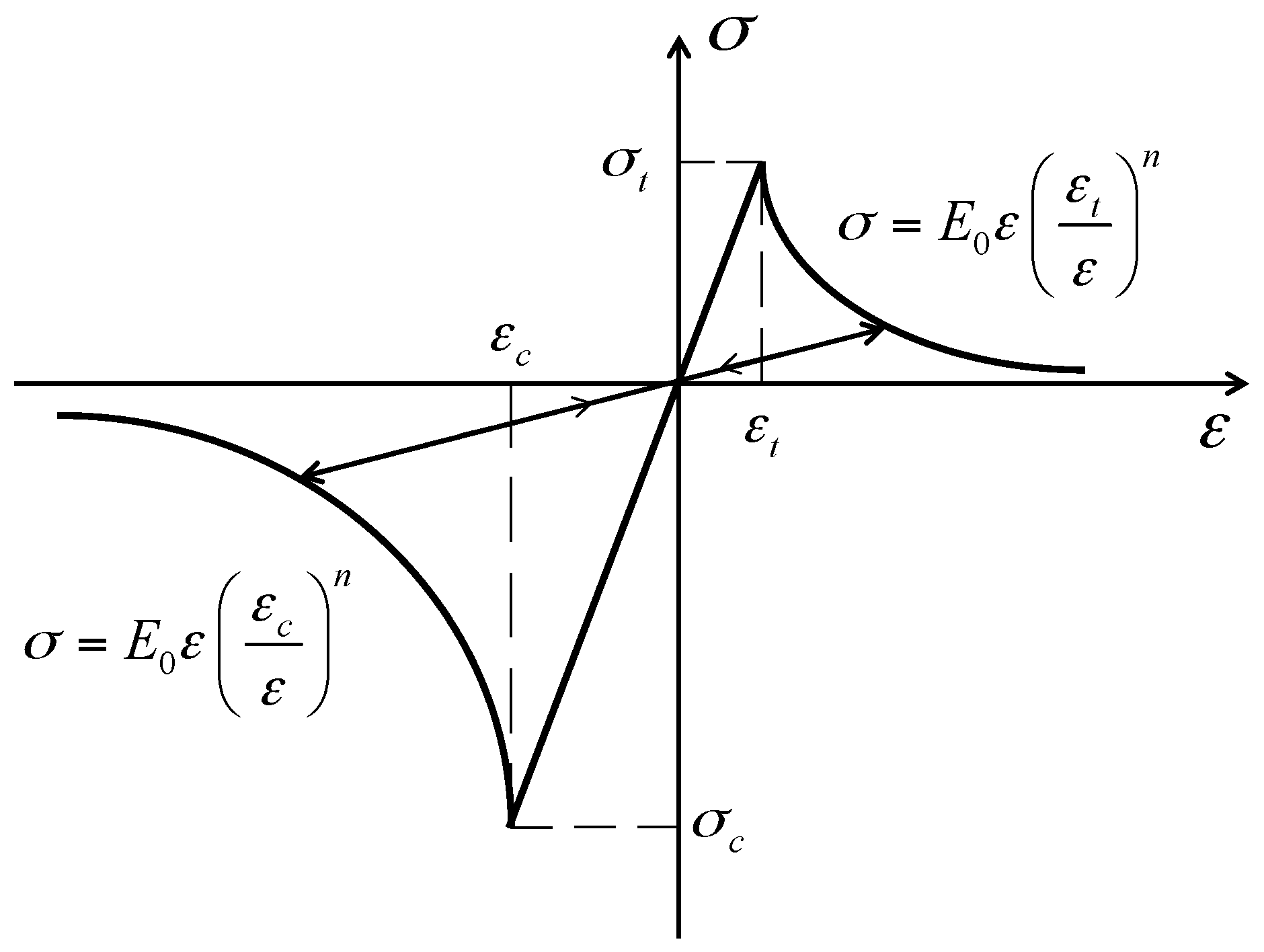
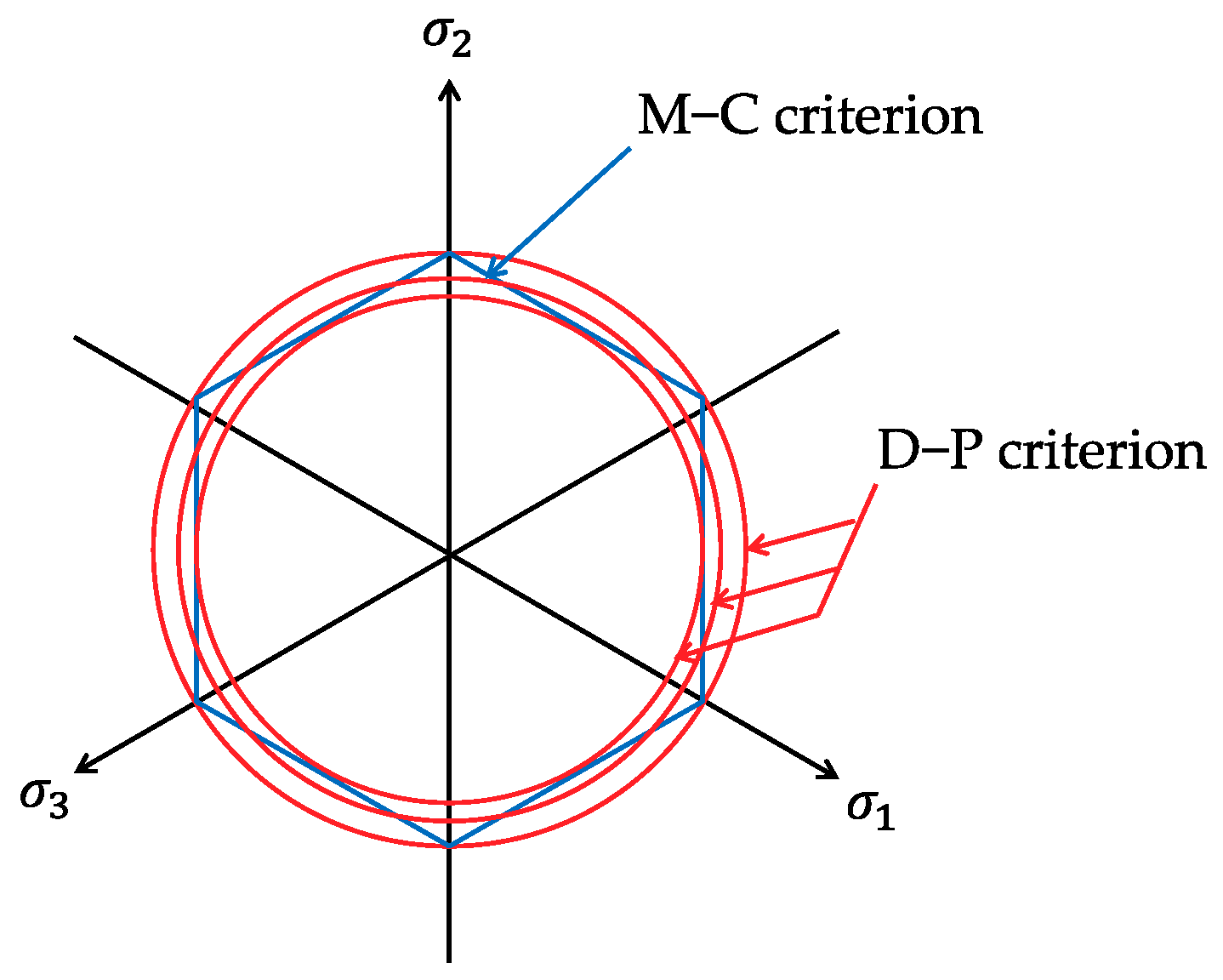
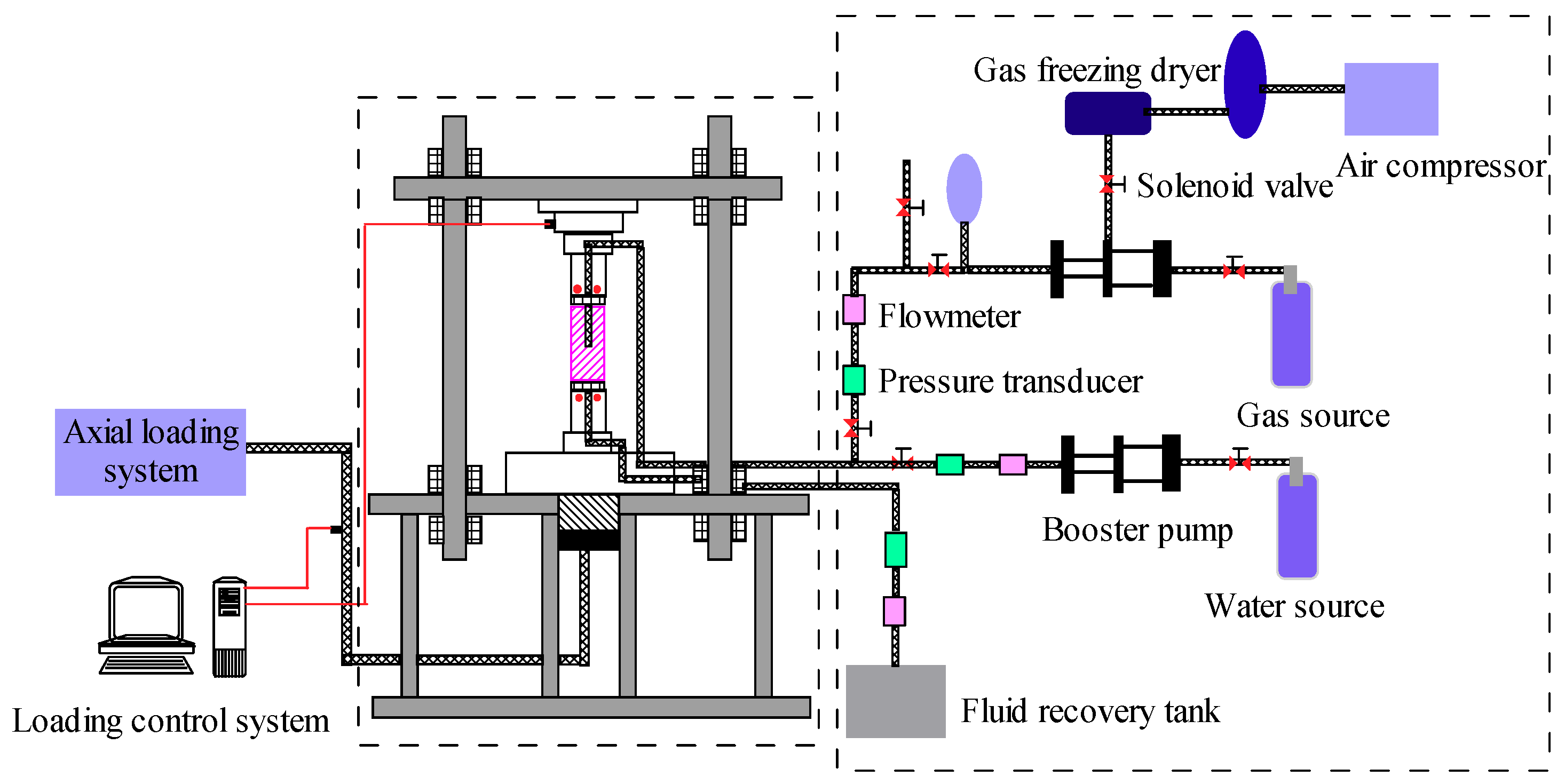

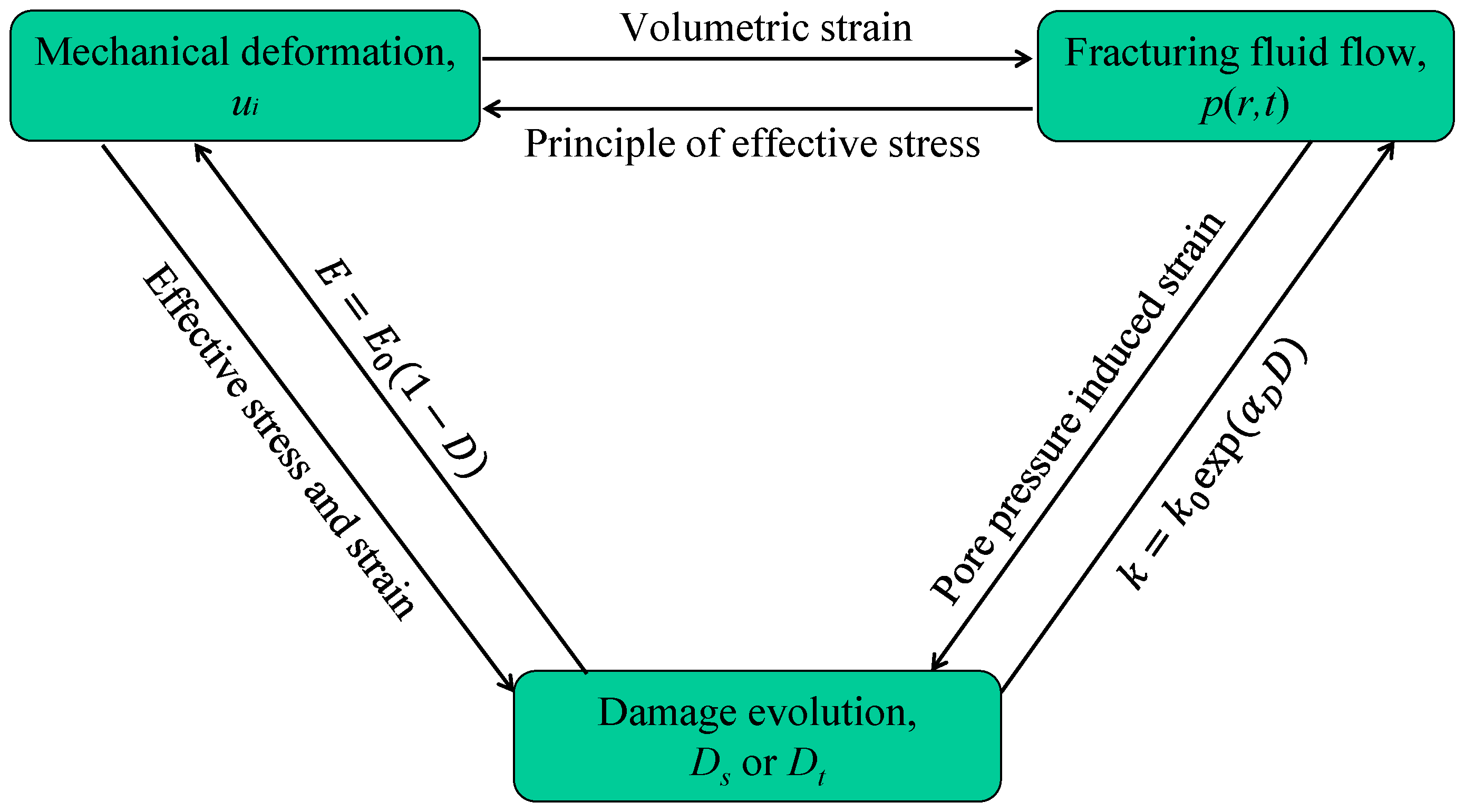



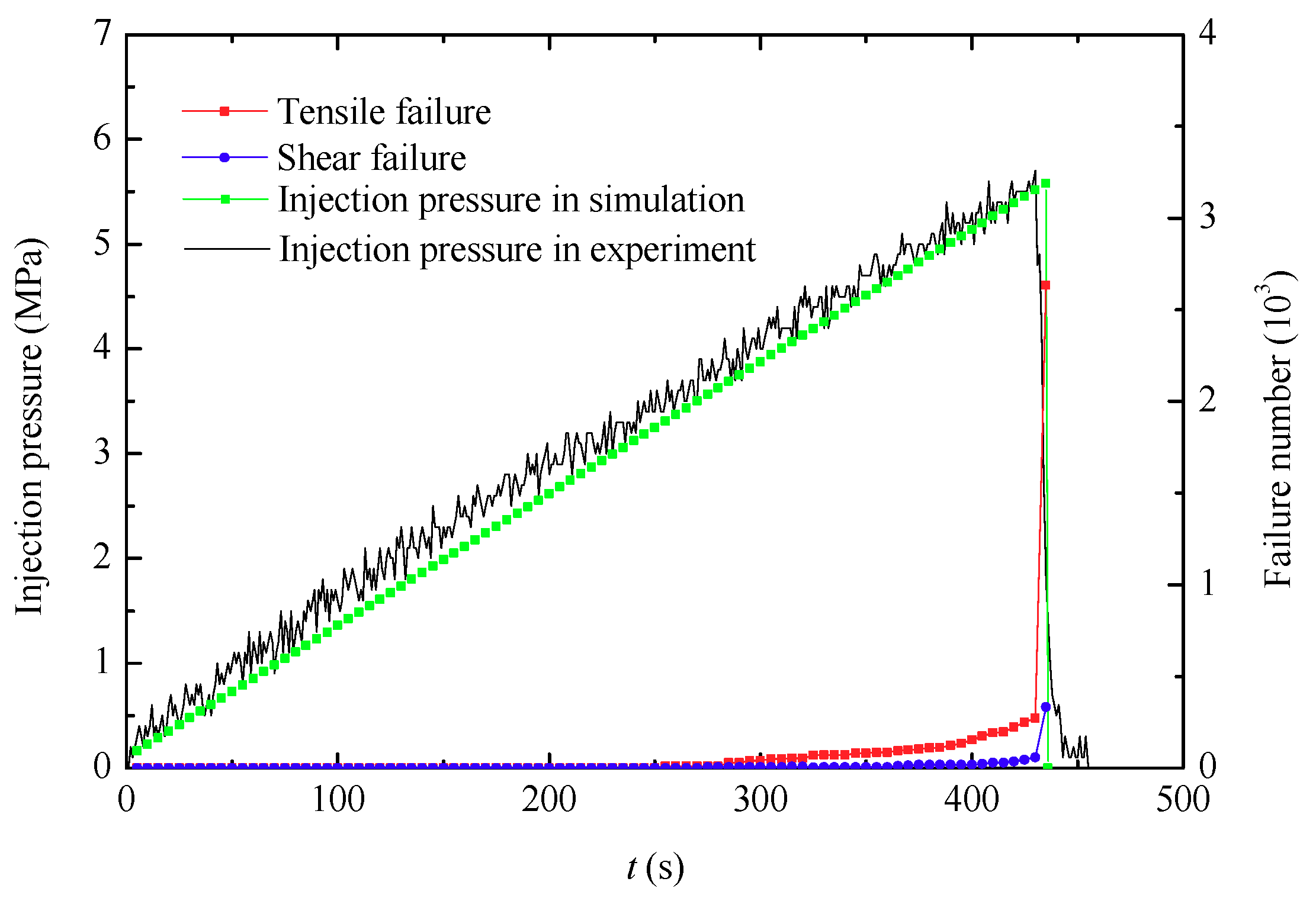
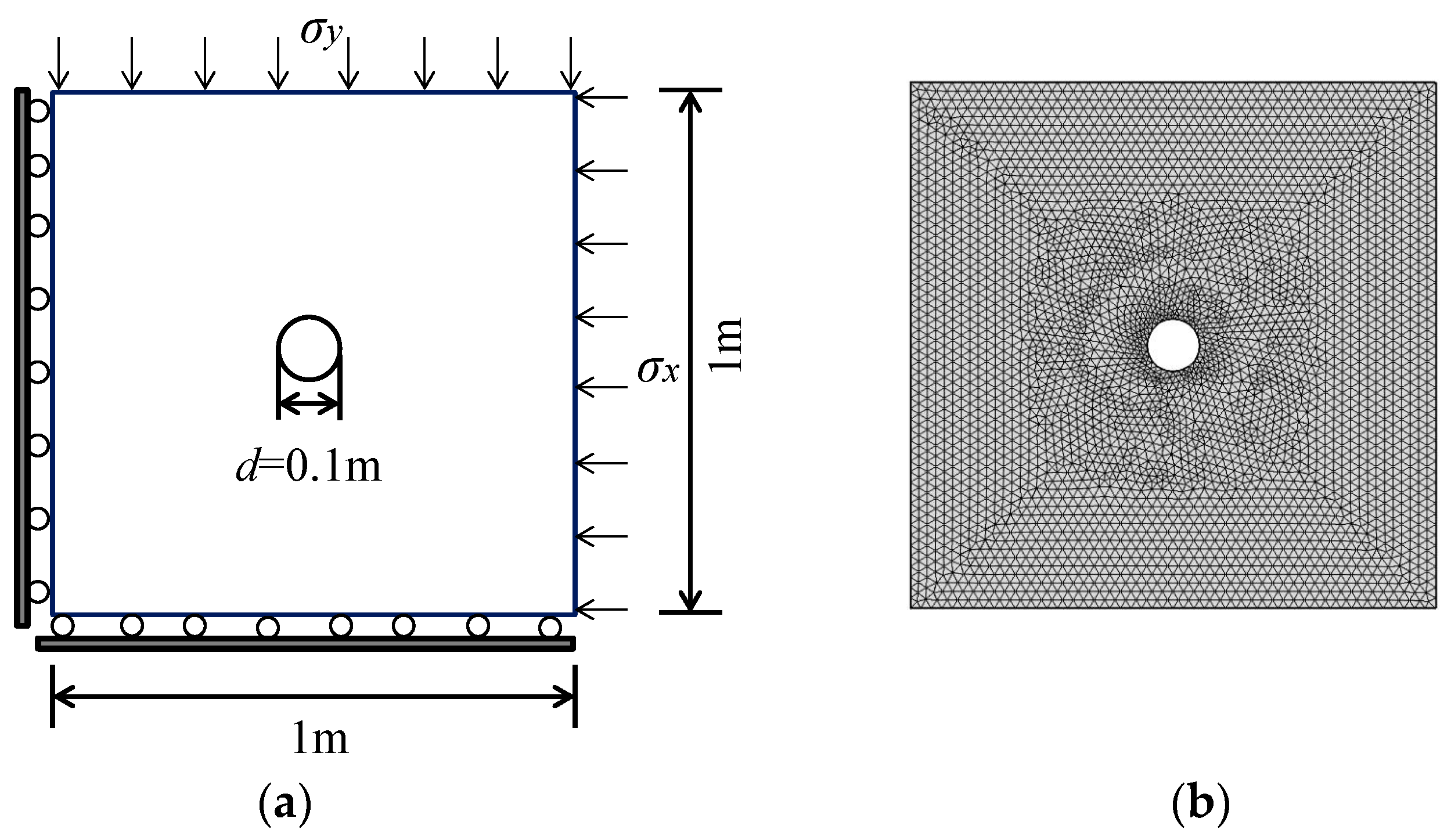
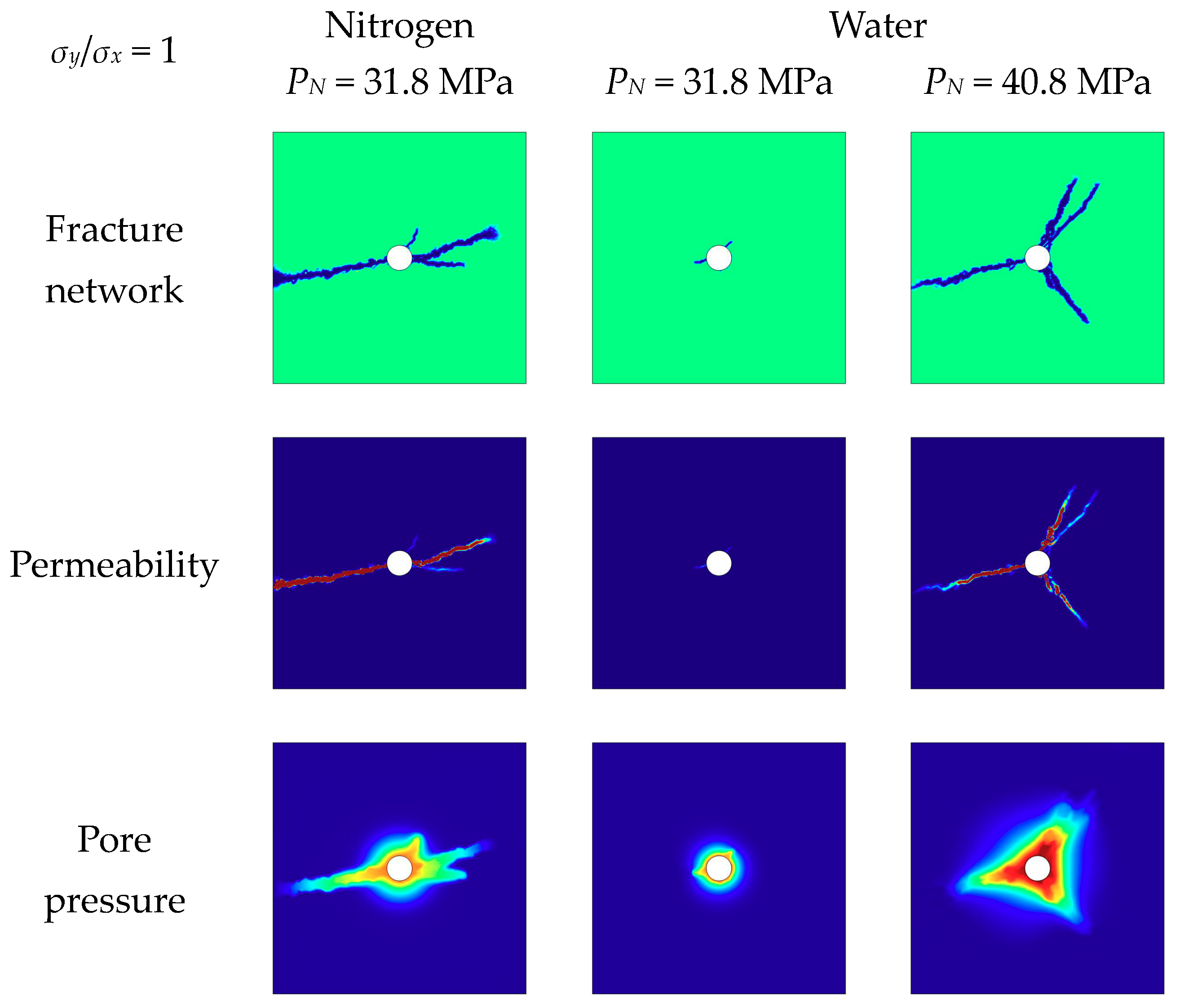



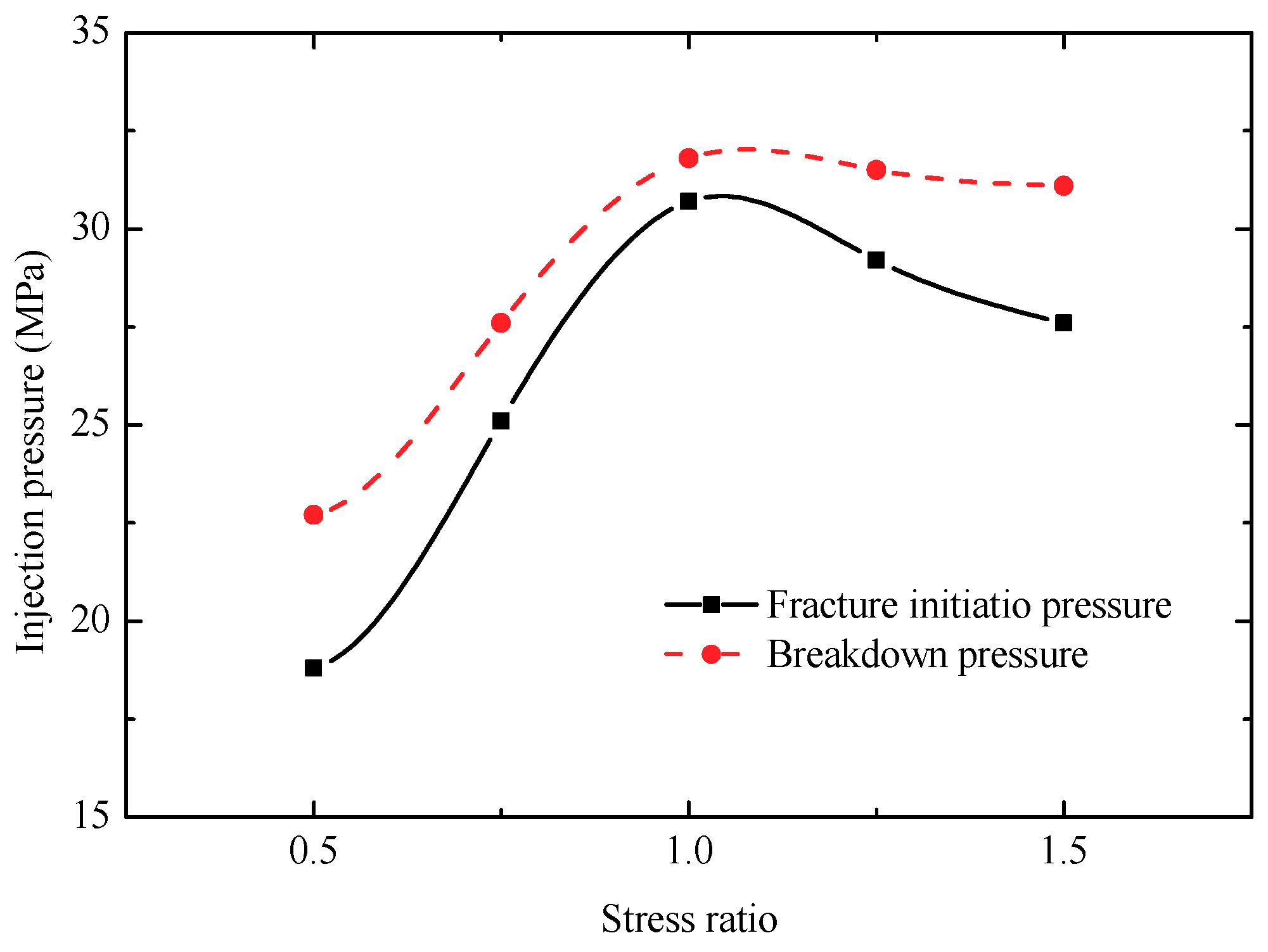
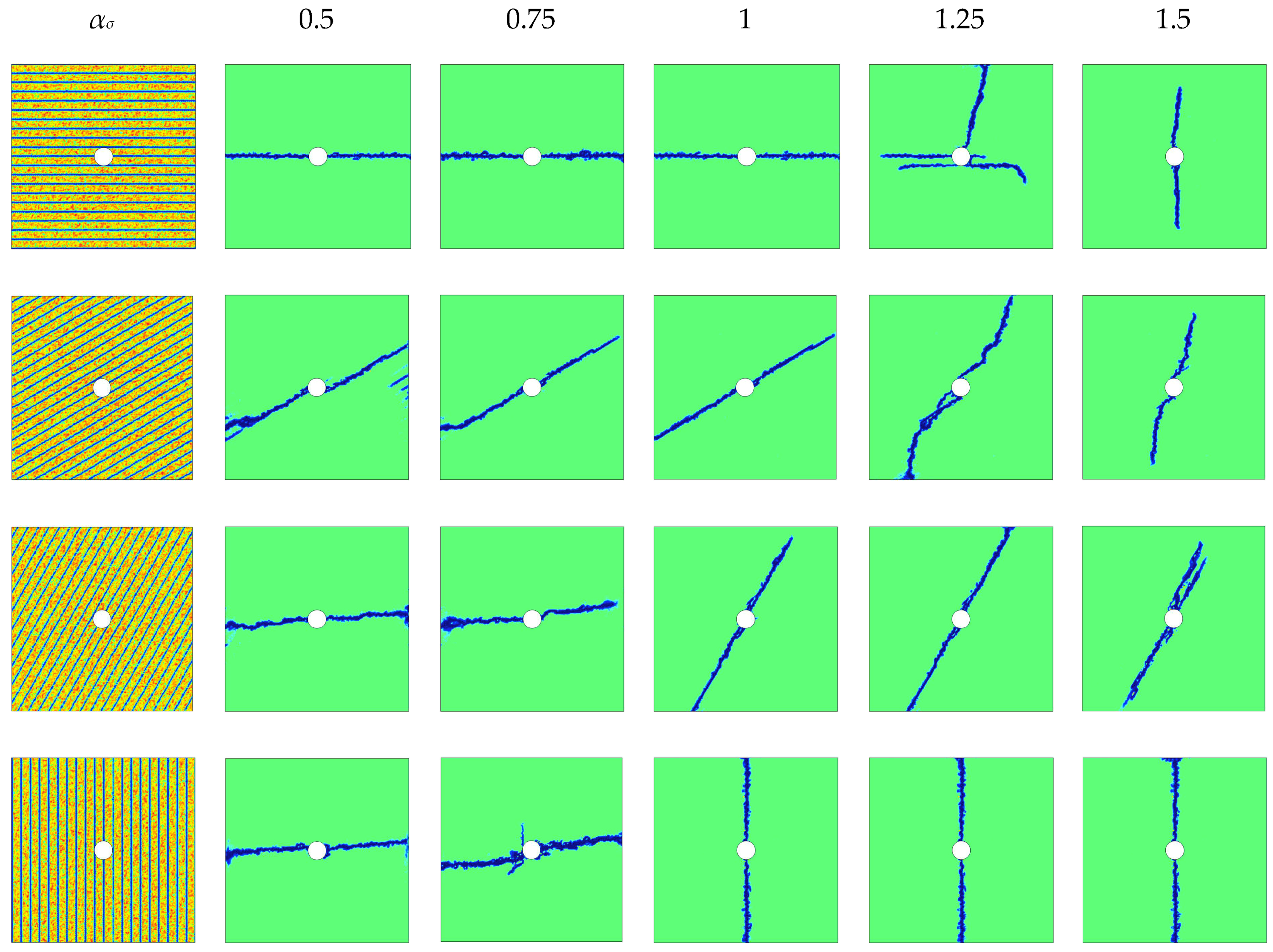

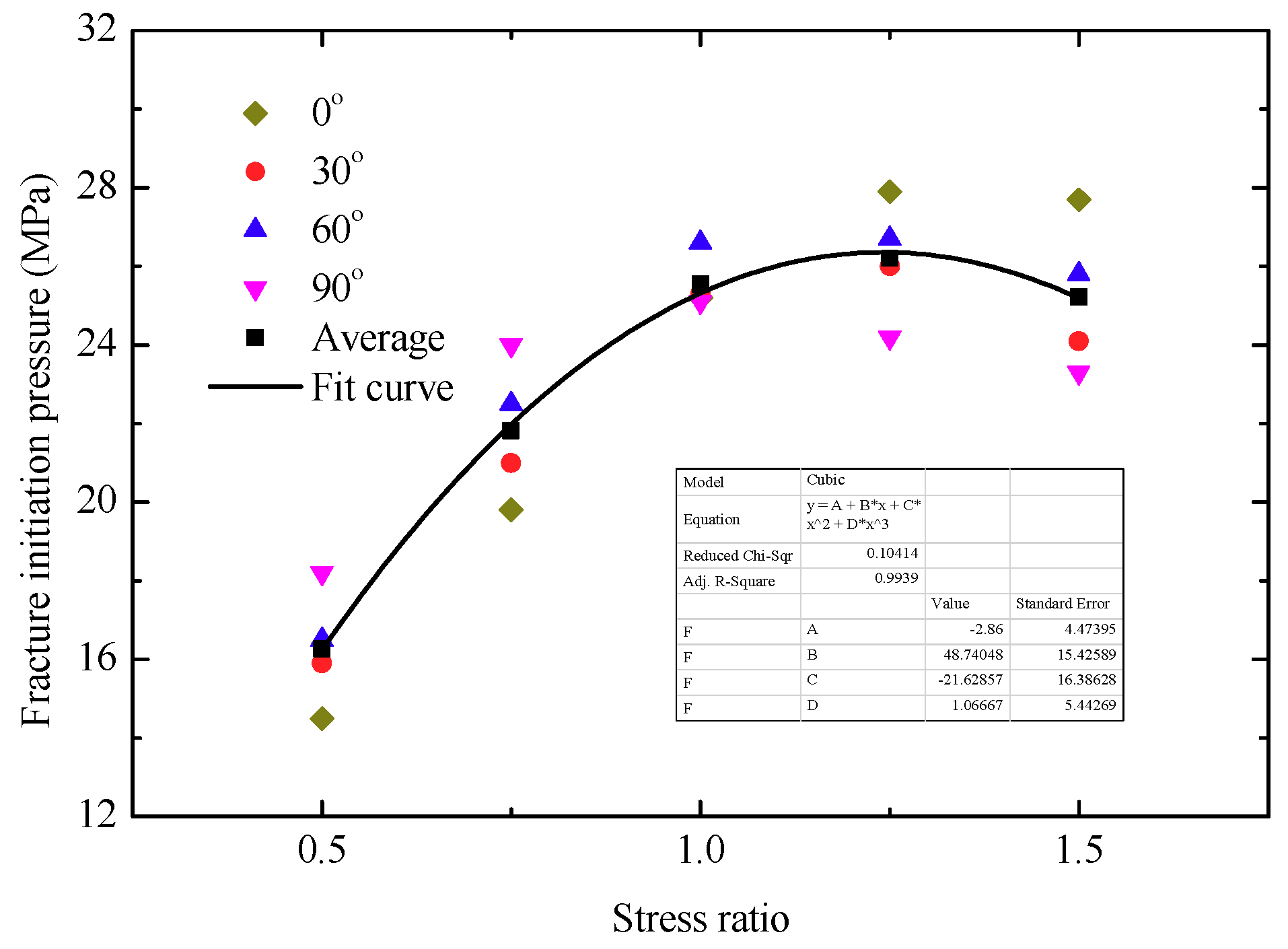
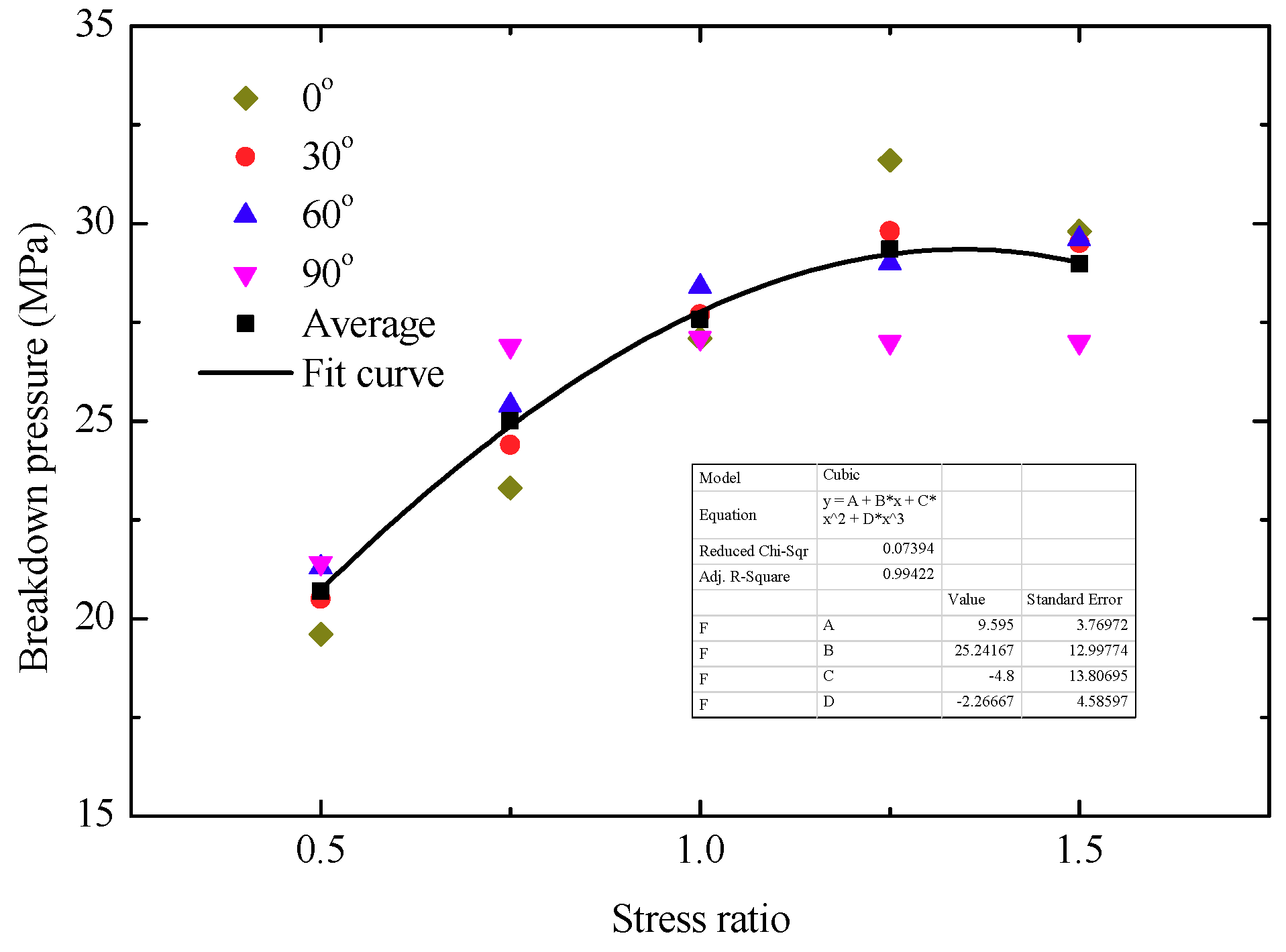

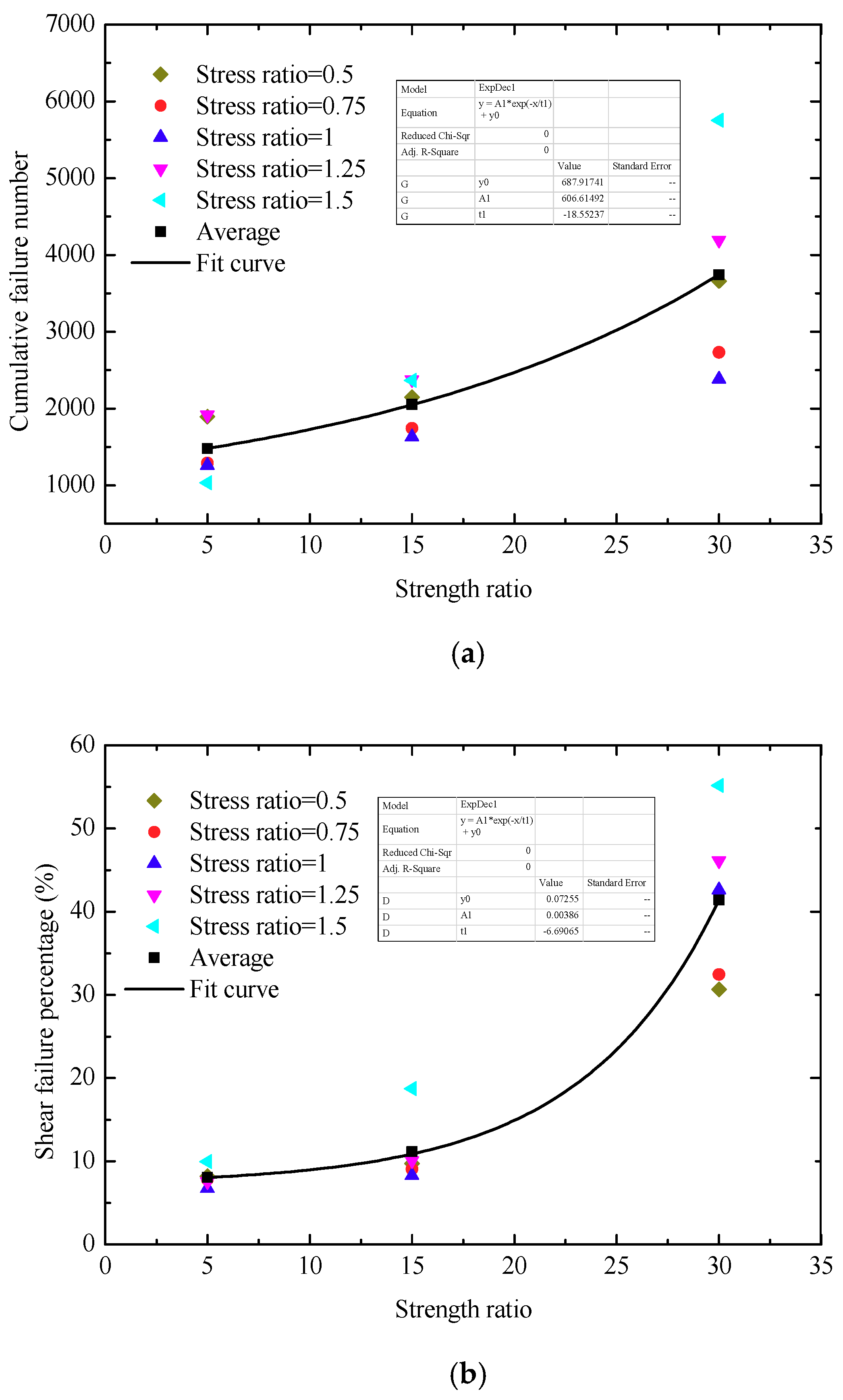
| Parameter | Matrix | Bedding |
|---|---|---|
| Young’s modulus, E0 (GPa) | 14 | 1.4 |
| Initial porosity, φ0 | 0.03 | 0.1 |
| Initial permeability, k0 (m2) | 1 × 10−18 | 1 × 10−17 |
| Tensile strength, σt (MPa) | 7.5 | 1.5 |
| Internal friction angle, φ | 30° | 20° |
| Cohesion, c (MPa) | 20 | 6 |
| Parameter | Value |
|---|---|
| Density of shale, ρs(kg/m3) | 2230 |
| Temperature, T (K) | 304 |
| Viscosity of nitrogen, μn (mPa·s) | 0.018 |
| Viscosity of water, μw(mPa·s) | 1 |
| Young’s modulus, E0 (GPa) | 14 |
| Shape parameter, b | 6 |
| Initial porosity, φ0 | 0.03 |
| Initial permeability, k0 (m2) | 1 × 10−18 |
| Poisson’s ratio, υ | 0.2 |
| Pressurization rate, lP (MPa/s) | 0.1 |
| Tensile strength, σt (MPa) | 7.5 |
| Internal friction angle, φ | 30° |
| Cohesion, c (MPa) | 20 |
© 2018 by the authors. Licensee MDPI, Basel, Switzerland. This article is an open access article distributed under the terms and conditions of the Creative Commons Attribution (CC BY) license (http://creativecommons.org/licenses/by/4.0/).
Share and Cite
Zhang, X.; Wang, J.; Gao, F.; Wang, X. Numerical Study of Fracture Network Evolution during Nitrogen Fracturing Processes in Shale Reservoirs. Energies 2018, 11, 2503. https://doi.org/10.3390/en11102503
Zhang X, Wang J, Gao F, Wang X. Numerical Study of Fracture Network Evolution during Nitrogen Fracturing Processes in Shale Reservoirs. Energies. 2018; 11(10):2503. https://doi.org/10.3390/en11102503
Chicago/Turabian StyleZhang, Xiangxiang, Jianguo Wang, Feng Gao, and Xiaolin Wang. 2018. "Numerical Study of Fracture Network Evolution during Nitrogen Fracturing Processes in Shale Reservoirs" Energies 11, no. 10: 2503. https://doi.org/10.3390/en11102503
APA StyleZhang, X., Wang, J., Gao, F., & Wang, X. (2018). Numerical Study of Fracture Network Evolution during Nitrogen Fracturing Processes in Shale Reservoirs. Energies, 11(10), 2503. https://doi.org/10.3390/en11102503







